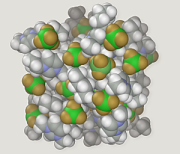GPU의 분자 모델링
Molecular modeling on GPUs
GPU(Abalone)에서 이온 액체 시뮬레이션
GPU의 분자 모델링은 분자 시뮬레이션을 위해 그래픽 처리 장치(GPU)를 사용하는 기법이다.[1]
엔비디아는 2007년 그래픽뿐만 아니라 과학적 계산에도 사용할 수 있는 비디오 카드를 선보였다. 이 카드에는 병렬로 작동하는 산술 단위(2016년[update] 기준, 테슬라 P100의 경우 최대 3,584개)가 다수 포함되어 있다. 이 사건이 일어나기 훨씬 전부터 비디오 카드의 연산력은 순수하게 그래픽 계산을 가속화하기 위해 사용되었다. 새로운 점은 엔비디아가 CUDA라는 이름의 고급 응용프로그래밍인터페이스(API)에서 병렬 프로그램 개발이 가능하도록 한 것. 이 기술은 프로그램을 C/C++로 작성할 수 있게 해 프로그래밍을 대폭 간소화했다. 최근에는 OpenCL이 교차 플랫폼 GPU 가속을 허용하고 있다.
양자 화학 계산과[2][3][4][5][6][7] 분자 역학 시뮬레이션[8][9][10](고전 역학 측면에서 분자 모델링)은 이 기술의 유익한 적용 분야 중 하나이다. 비디오 카드는 계산을 수십 번 가속할 수 있기 때문에 이런 카드를 가진 PC는 공통 프로세서를 기반으로 한 워크스테이션 클러스터와 비슷한 파워를 가지고 있다.
GPU 가속 분자 모델링 소프트웨어
프로그램
- 전복 – 분자역학(벤치마크)
- 2009년 이후 GPU에 대한 ACEMD
- GPU 버전의 황색
- GPU 버전에 대한 Ascalap – Ascalap Liquid GPU
- AutoDock – 분자 도킹
- 웨이블렛 기반 BigDFT Ab initio 프로그램
- BrianQC 양자화학(HFT와 DFT)과 분자역학
- 블레이즈 리간드 기반 가상 선별
- CP2K Ab initio 분자 역학
- GPU, 워크스테이션 및 클러스터의 데스몬드(소프트웨어)
- Firefly(이전의 PC GAMESS)
- 패스트ROCS
- GOMC – GPU 최적화 몬테카를로 시뮬레이션 엔진
- GPIUTMD – Multi-Particle Dynamics용 그래픽 프로세서
- GPU의 GROMACS
- HALMD – 가속도가 높은 대규모 MD 패키지
- HOOMD-blue – 고도로 최적화된 객체 지향 다분파 동적—Blue Edition
- GPU의 LAMPS 버전 – 가속기용 램프
- LIO DFT 기반 GPU 최적화 코드 - [1]
- 옥토퍼스는 OpenCL을 지지한다.
- oxDNA – GPU에 대한 DNA와 RNA의 거친 결절 시뮬레이션
- PWmat – 평면파 밀도 기능 이론 시뮬레이션
- RUMD - Roskilde University Molecular Dynamics[12]
- TeraChem – 양자 화학 및 ab initio Molecular Dynamics
- GPU에 팅커.[13]
- GPU 버전의 VMD & NAMD
- 야사라는 OpenCL을 사용하여 모든 GPU에 대해 MD 시뮬레이션을 실행한다.
API
- BrianQC – GPU에 대한 양자 화학 시뮬레이션을 위한 개방형 C 레벨 API를 보유하고 있으며, GPU 가속 버전의 Q-Chem 및 PSI를 제공한다.
- OpenMM – GPU에서 분자 역학을 가속화하기 위한 API, v1.0은 GPU 가속 버전의 GROMACS를 제공한다.
- mdcore – 최신 공유 메모리 병렬 아키텍처에 대한 분자 역학 시뮬레이션을 위한 오픈 소스 플랫폼 독립 라이브러리.
분산 컴퓨팅 프로젝트
참고 항목
참조
- ^ John E. Stone, James C. Phillips, Peter L. Freddolino, David J. Hardy 1, Leonardo G. Trabuco, Klaus Schulten (2007). "Accelerating molecular modeling applications with graphics processors". Journal of Computational Chemistry. 28 (16): 2618–2640. CiteSeerX 10.1.1.466.3823. doi:10.1002/jcc.20829. PMID 17894371.
{{cite journal}}: CS1 maint : 복수이름 : 작성자 목록(링크) - ^ Koji Yasuda (2008). "Accelerating Density Functional Calculations with Graphics Processing Unit". J. Chem. Theory Comput. 4 (8): 1230–1236. doi:10.1021/ct8001046. PMID 26631699.
- ^ Koji Yasuda (2008). "Two-electron integral evaluation on the graphics processor unit". Journal of Computational Chemistry. 29 (3): 334–342. CiteSeerX 10.1.1.498.364. doi:10.1002/jcc.20779. PMID 17614340.
- ^ Leslie Vogt; Roberto Olivares-Amaya; Sean Kermes; Yihan Shao; Carlos Amador-Bedolla; Alán Aspuru-Guzik (2008). "Accelerating Resolution-of-the-Identity Second-Order Møller−Plesset Quantum Chemistry Calculations with Graphical Processing Units". J. Phys. Chem. A. 112 (10): 2049–2057. Bibcode:2008JPCA..112.2049V. doi:10.1021/jp0776762. PMID 18229900.
- ^ Ivan S. Ufimtsev & Todd J. Martinez (2008). "Quantum Chemistry on Graphical Processing Units. 1. Strategies for Two-Electron Integral Evaluation". J. Chem. Theo. Comp. 4 (2): 222–231. doi:10.1021/ct700268q. PMID 26620654.
- ^ Ivan S. Ufimtsev & Todd J. Martinez (2008). "Graphical Processing Units for Quantum Chemistry". Computing in Science & Engineering. 10 (6): 26–34. Bibcode:2008CSE....10f..26U. doi:10.1109/MCSE.2008.148.
- ^ Gábor J. Tornai; István Ladjánszki; Ádám Rák; Gergely Kis & György Cserey (2019). "Calculation of quantum chemical two-electron integrals by applying compiler technology on GPU". J. Chem. Theo. Comp. 15 (10): 5319–5331. doi:10.1021/acs.jctc.9b00560. PMID 31503475.
- ^ Joshua A. Anderson; Chris D. Lorenz; A. Travesset (2008). "General Purpose Molecular Dynamics Simulations Fully Implemented on Graphics Processing Units". Journal of Computational Physics. 227 (10): 5342–5359. Bibcode:2008JCoPh.227.5342A. CiteSeerX 10.1.1.552.2883. doi:10.1016/j.jcp.2008.01.047.
- ^ Christopher I. Rodrigues; David J. Hardy; John E. Stone; Klaus Schulten & Wen-Mei W. Hwu. (2008). "GPU acceleration of cutoff pair potentials for molecular modeling applications". In CF'08: Proceedings of the 2008 Conference on Computing Frontiers, New York, NY, USA: 273–282.
- ^ Peter H. Colberg; Felix Höfling (2011). "Highly accelerated simulations of glassy dynamics using GPUs: Caveats on limited floating-point precision". Comput. Phys. Commun. 182 (5): 1120–1129. arXiv:0912.3824. Bibcode:2011CoPhC.182.1120C. doi:10.1016/j.cpc.2011.01.009.
- ^ Yousif, Ragheed Hussam (2020). "Exploring the Molecular Interactions between Neoculin and the Human Sweet Taste Receptors through Computational Approaches" (PDF). Sains Malaysiana. 49 (3): 517–525. doi:10.17576/jsm-2020-4903-06.
- ^ Bailey, Nicholas; Ingebrigtsen, Trond; Hansen, Jesper Schmidt; Veldhorst, Arno; Bøhling, Lasse; Lemarchand, Claire; Olsen, Andreas; Bacher, Andreas; Costigliola, Lorenzo; Pedersen, Ulf; Larsen, Heine (2017-12-14). "RUMD: A general purpose molecular dynamics package optimized to utilize GPU hardware down to a few thousand particles". SciPost Physics. 3 (6): 038. doi:10.21468/SciPostPhys.3.6.038. ISSN 2542-4653.
- ^ M. Harger, D. Li, Z. Wang, K. Dalby, L. Lagardère, J.-P. Piquemal, J. Ponder, P. Ren (2017). "Tinker-OpenMM: Absolute and relative alchemical free energies using AMOEBA on GPUs". Journal of Computational Chemistry. 38 (23): 2047–2055. doi:10.1002/jcc.24853. PMC 5539969. PMID 28600826.
{{cite journal}}: CS1 maint : 복수이름 : 작성자 목록(링크)


